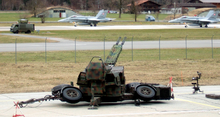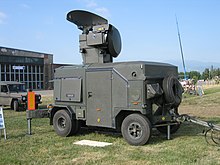Oerlikon 35mm twin cannon

The Oerlikon 35 mm twin cannon is a mobile anti- aircraft gun (Flak), which consists of two cannons from the KD series from the former Swiss company Oerlikon-Bührle (since 2009 Rheinmetall Air Defense ). Originally the weapon system was named 2 ZLA / 353 ML , but later changed to GDF-001 . Although it was developed in the 1950s, the flak is still used in more than 30 countries today.
development
The development of the KD series began in 1952. The experts at Oerlikon calculated the 35 × 228 mm caliber as the optimum for anti-aircraft guns. The weapon was derived from the 20mm KAA-GK cannon developed after World War II . Various types were developed, including a water-cooled MK 352 variant that was tested by the US Navy . The series version MK 323 was produced in two variants, namely with a belt feed (KDA and KDB) and with a five-shot magazine (KDC). All types are gas pressure chargers with the bolt locked rigidly when firing and mechanical ignition of the cartridge. The names of the guns are derived from K anone, D (the internal name at Oerlikon for the 35 mm caliber) and A (up to F) for the respective type.
The developed from weapons systems use always two 35mm automatic cannon of the KD-series. They can be remotely controlled with the Super Fledermaus fire control radar , which was replaced by the improved Skyguard system in the late 1970s .
In 1980 a further developed model, the GDF-002, was produced, which received an improved aiming device and the possibility of remote control of the weapon via an external fire control system. A few years later, the third version, the GDF-003, was introduced, which was very similar to the previous one. As extensions, the weapon was designed to be self-lubricating and provided with an integrated protective cover. With the development GDF-005 produced from 1985 onwards , the Gunking 3D computer targeting device with a laser range finder and digital control system was introduced. The weapon has 112 rounds ready to fire, 128 in reserve. The cannon has a four-wheeled hinged undercarriage and is pulled by a truck for transport, but can also be pulled by hand by six men (on flat terrain).
The 35 mm guns of the KD series are now mounted in the Gepard anti-aircraft gun tank and in the British Marksman . Under the designation Naval Gun Type GDM-A, they are also used on ships for air defense and local defense.
Super bat
The Contraves Superfledermaus fire control system was jointly developed and produced by ten companies. On a towed trailer, it comprises a Doppler radar in the E / F band with a range of 15 kilometers and a pulse Doppler radar in the J band, also with a range of 15 kilometers. The system was also used in the first prototype of the Gepard anti-aircraft tank.
Skyguard
The Skyguard fire control system is also transported in a trailer. A pulse Doppler search radar and fire control radar as well as a coaxial camera are built on this . The control instruments and the gasoline-powered generator are built into the trailer. In addition, 3 men of the operating team, consisting of the fire control officer , the equipment chief, the locator, judge, searcher and the equipment manager are accommodated.
A Skyguard anti-aircraft fire unit consists of the Skyguard and two twin anti-aircraft guns.
history
- On the basis of a federal decree of December 13, 1961, the weapon was introduced in Switzerland from 1963 under the name 35 mm Flab Kan 63 with the fire control system 63 (super bat).
- The weapon system was used by Argentina during the Falklands War . Both fire control systems were used and on May 4, 1982 a Sea Harrier (XZ450) was shot down. As a consequence, British pilots avoided the air defense positions more spacious. Furthermore, an RAF Harrier (XZ988) was shot down on May 27, 1982 over Goose Green . The weapon system was also used against British troops in the battle for Goose Green.
- In 2007, nine South African soldiers were killed and 14 injured during an exercise. As a result of a defect, a cannon turned sideways and fired uncontrollably at the surrounding area.
ammunition

| NATO designation | NESS | HEI | HEI (BF) | SAPHEI-T | FAPDS | TP-T / TP | AHEAD |
|---|---|---|---|---|---|---|---|
| Bullet weight | 535 g | 550 g | 550 g | 550 g | 375 g | 550 g | 750 g |
| explosive | 98 g | 112 g | 70 g | 22 g | n / A | n / A | n / A |
| Propellant charge | 330 g | ||||||
| Cartridge weight | 1565 g | 1580 g | 1580 g | 1552 g | 1440 g | 1580 g | 1780 g |
| Muzzle velocity | 1175 m / s | 1175 m / s | 1175 m / s | 1175 m / s | 1440 m / s | 1175 m / s | 1050 m / s |
-
Description :
- HEI - High Explosive Incendiary ( -T - Tracer), high explosive / incendiary charge
- SAPHEI - Semi-Armor Piercing High Explosive Incendiary (explosive-filled half armor-piercing projectile with incendiary effect)
- FAPDS - Frangible Armor Piercing Discarding Sabot (armor-piercing sub-caliber bullet that breaks up in the target)
- AHEAD - Advanced Hit Efficiency and Destruction, timed ammunition with 152 heavy tungsten sub-projectiles.
- TP - Target Practice ( -T - Tracer), practice ammunition without explosives
The types used in the Bundeswehr can be found in the list of Bundeswehr ammunition.
Versions
- GDF-001/2 ZLA / 353 MK: XABA target device
- GDF-002: introduced in 1980; improved Ferranti aiming device and digital data transmission
- GDF-003: minor improvements; Weapon designed to be self-lubricating and with an integrated protective cover
- GDF-005: introduced in 1985; equipped with a gunking 3D computer aiming device, laser range finder and digital fire control system; built-in power supply and fault diagnosis
- GDF-006: GDF-001/002/003 variants; equipped with a system for firing AHEAD ammunition
- GDF-007: GDF-005 variant; equipped with a system for firing AHEAD ammunition
- GDF-CO3 mobile air defense system
- AHEAD: A system that allows the GDF series weapons to fire AHEAD ammunition .
- Gepard , Marksman , Type 87 and PZA Loara are different anti-aircraft gun tanks that were developed using the KDA version of the gun.
commitment
-
 Argentina 44 GDF-002 units
Argentina 44 GDF-002 units -
 Egypt
Egypt
-
 Bahamas
Bahamas
-
 Brazil
Brazil
-
 Chile
Chile
-
 Germany main armament of the Gepard anti-aircraft cannon tank (now decommissioned)
Germany main armament of the Gepard anti-aircraft cannon tank (now decommissioned) -
 Ecuador
Ecuador
-
 Finland 16 units, known as 35 ITK 88
Finland 16 units, known as 35 ITK 88
-
 Greece
Greece
-
 Iran
Iran
-
 Japan some GDF- 001 units
Japan some GDF- 001 units - Cameroon
-
 Cambodia
Cambodia
-
 Canada 20 GDF-005 units are being retired
Canada 20 GDF-005 units are being retired -
 Kuwait
Kuwait
-
 Malaysia
Malaysia
-
 Oman
Oman
-
 Austria
Austria
-
 Pakistan
Pakistan
-
 Romania
Romania
-
 Saudi Arabia
Saudi Arabia
-
 Switzerland 24 fire units GDF-005, known as 35 mm Flab Kan 63/90
Switzerland 24 fire units GDF-005, known as 35 mm Flab Kan 63/90
-
 Singapore
Singapore
-
 Spain
Spain
-
 South Africa 150 GDF-002 units
South Africa 150 GDF-002 units -
 South Korea
South Korea
-
 Taiwan
Taiwan
-
 Turkey
Turkey
-
 United Arab Emirates
United Arab Emirates
-
 United Kingdom : The British captured 15 twin GDF-002 cannons during the Falklands War. The cannon's fire control (skyguard) systems are currently being used to detect British military aircraft flying into restricted areas.
United Kingdom : The British captured 15 twin GDF-002 cannons during the Falklands War. The cannon's fire control (skyguard) systems are currently being used to detect British military aircraft flying into restricted areas. -
 People's Republic of China
People's Republic of China
-
 Cyprus
Cyprus
Technical data GDF-006/7
- Dimensions:
- Caliber: 35 mm
- Length of the weapon: 4740 mm
- Width: 356 mm
- Height: 640 mm
- Length of the tube with V 0 measuring base: 3710 mm
- Length of the drawn part: 2923 mm
- Twist type: Progressive twist right
- Twist length: 2853 mm
- Twist angle: 0 ° –6 ° 30 "
- Number of Trains: 24 '
- Weight:
- Cannon ready to fire: 6700 kg (including ammunition)
- Tube with V 0 measuring base: 175 kg
- Gun housing: 200 kg
- Locking buffer: 12.5 kg
- Closure: 11 kg
- Gun blanket: 106 kg
- Ammunition:
- Sub and full caliber types, air bursting ammunition (ABM)
- Cadence:
- Max. 550 rounds / min (per tube)
literature
- James C. O'Halloran: Jane's Land-Based Air Defense 2005-2006. ISBN 0-7106-2697-5 (English).
- George M. Chinn: The Machine Gun. Volume V. (English).
Web links
- Manufacturer's website - Rheinmetall Defense
- Info about the KDA cannon on Army Guide (English)
- Skyguard-Sparrow (Russian)
- Accident in South Africa (English)
Individual evidence
- ^ RAF Harrier Ground Attack-Falklands, by Jerry Pook, ISBN 978-1-84415-551-4 , p. 109
- ↑ http://blog.wired.com/defense/2007/10/robot-cannon-ki.html in the internet archive
- ↑ 24 fire units anti-aircraft cannon 35 mm, VBS documentation - The Army in Figures (status 02/2011) ( Memento from February 24, 2014 in the Internet Archive )
- ^ House of Commons Hansard for 11 Feb 2002 (pt 5) .



